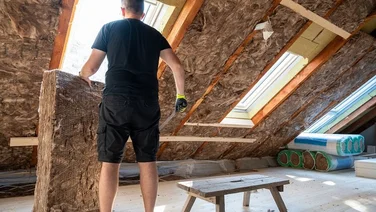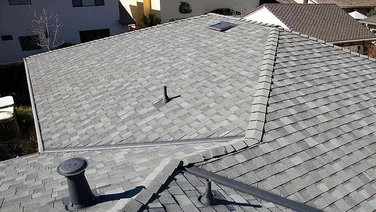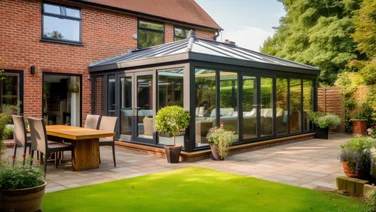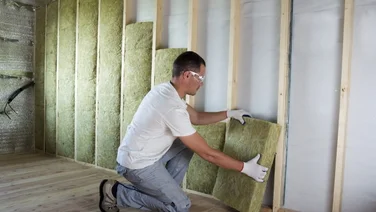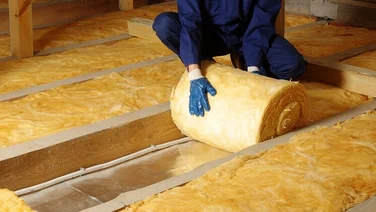- Loft insulation will typically save you £355 per year
- It can cut more than a tonne of CO2 from your carbon footprint
- The insulation will typically be effective for at least 40 years
Loft insulation can make your home warmer and, therefore, cosier year round. Not to mention the savings you can get on your energy bills, too.
Loft insulation typically lasts 40 years, but there are different types to choose from that could impact this, as well as the overall price you’ll pay. These are spray foam, blown fibre, blanket, loose fill and sheet insulation.
Spray foam, blown fibre and sheet insulation are applied to the inner roof of the loft, while blanket and loose fill are installed in the floor of the attic.
In this guide, we’ll go through each type in more detail to help make your home warmer and save you £££s on your annual energy bills. But if you’re already clued up and want to go straight to a quote, fill in our no obligation form and our trusted suppliers will be in touch.
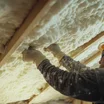
Get free insulation quotes
Answer a few quick questions, and our trusted installers will send you bespoke insulation quotes.
What is loft insulation?
Loft insulation is a shield you can install between the loft and the rest of your home – to keep the warmth in the rooms below – and on the underside of the roof, to retain your loft’s heat.
The insulating material you use will usually be made of mineral wool, organic foam or rigid insulation boards.
You or a professional will fit this material between your rafters – the beams on your roof – or your joists, the beams on your loft floor.
What are the benefits of loft insulation?
Whichever type of insulation you choose, you’re likely to save money on your energy bills. In fact, you can expect savings of up to £340 per year, according to the Energy Saving Trust.
But that’s not all.
Insulating your loft and/or roof will increase your comfort levels year-round, as your home will naturally feel warmer. This is in addition to cutting your carbon footprint.
How much you’ll save will depend on the size of your home. A detached house with solid wall insulation could save up to 1,500kg of CO2 emissions per year, while those with a semi-detached or terraced house could save between 620kg and 550kg of CO2 emissions per year respectively.
A mid-terrace house could save up to 560kg of CO2 emissions per year and a mid-floor flat could save up to 440kg of CO2 emissions per year.
Insulating your home can also increase its value, as it makes your home more attractive to buyers. This is because it can improve the look of your home, improve its energy efficiency and even prevent condensation issues, which can be a turn-off from prospective buyers.
What types of loft insulation are there?
There are a few different types of loft insulation, but finding the one for your space is relatively easy.
You can make the decision based on your roof’s shape, the space and condition of your loft, and the loft’s intended use. Let’s run through what those options:
- Flat roof: Don’t attempt to insulate a flat roof yourself. Flat roofs should be insulated from above, meaning the installation would require you to stand on the roof – a dangerous undertaking for an amateur. It also calls for a high level of expertise to ensure it’s both effective and compliant with the latest regulations. The expert you hire will either lay a rigid insulation board on top of your roof’s weatherproof layer, or directly on to the rafters below it.
- Storage space: If you see your loft as a storage space, you’ll want a flat surface for your items to be stored on. You’ll need to lay boards after fitting mineral wool insulation between the joists. Make sure you don’t push the insulation material down when you fit the boards as this can make it less effective. Leave a ventilated air gap above your insulation.
- Warm loft: Instead of going above the rafters, hire a professional to fit insulation between or below them. They will either use rigid insulation boards that have been cut to fill the space between your rafters or spray foam insulation in those gaps instead. This will stop heat getting out of your home through the roof. This extra warmth will allow you to board over your loft insulation without having to buy wooden battens or plastic legs to fit in more insulating material. The downside is that this method can be more expensive.
- Bedroom: Getting your loft insulated is an effective way to turn it into an extra bedroom. As lofts have external walls open to the elements, you’ll need a professional to insulate all the walls and the ceiling so that it’s warm enough to live in.
- Inaccessible space: No one aspires to have an inaccessible loft space, but sometimes you don’t get a choice. In this case, you can hire a professional who will use tubes to blow insulation into the loft, thus keeping the warmth where you need it – in accessible spaces. The insulation will typically consist of mineral wall, organic foam or treated cellulose. But, most importantly, it’ll retain more heat while cutting energy bills and emissions.

How much does roof and loft insulation cost?
Roof and loft insulation costs tend to vary, depending on a number of factors. Overall, it’s usually much cheaper than many other home improvements, typically starting from £10 per metre squared for traditional quilt insulation or £12 per metre squared for loose-fill insulation.
The total cost you’ll pay will depend on the home you have, and the area you need covered.
There’s also labour costs to consider. This can be around £250 a day, according to Checkatrade.
You can expect savings of £340 per year on your energy bills, meaning you should recoup your initial expense in no longer than three years.
What do I need to think about when choosing loft and roof insulation?
You will need to consider the following:
- Don’t let your loft become a damp squib: Before you install your insulation, get a professional assessment to check for damp. Insulating your loft could introduce or exacerbate dampness, which is the last thing you want. An expert will be able to tell you how to ensure your loft has enough ventilation to avoid issues.
- What is your loft’s purpose? The type of insulation you choose will depend on what you want your loft to be used for. You might want to cut your energy waste or install another bedroom, office space or play area. There are a lot of possibilities.
- Insulation can make a space colder: Insulating the floor of your loft is a double-edged sword. It’ll keep the rest of your home warm but your loft will be colder. This does mean any pipes or water tanks in the loft might freeze, so make sure to insulate them.
Are there any government grants for loft and roof insulation?
There’s one grant you can apply for that will help alleviate some of the costs involved to install loft insulation. The ECO4 scheme can also be used for the installation of a new roof.
Since 2013, The Energy Company Obligation scheme requires large UK companies to provide low-income homes and people on certain benefits with heat-saving methods, including loft and roof insulation. The ECO4 scheme is the fourth iteration of this in Great Britain.
The scheme covers insulation, boiler repairs and heat pump installation. There is no set amount of funding you can receive since it’s dependent on your home’s needs. The energy company you choose to work with is responsible for the level of funding, as well as for the projects and installers that are used. The level of funding will also depend on the work your house needs, plus a number of other factors.
You can contact any of the suppliers listed by the scheme to do the work, provided you meet the eligibility criteria. The scheme runs in England, Scotland and Wales, and will run until 31 March 2026.
These are the criteria you must meet to be eligible for a grant:
- Your home has a low EPC rating, which typically means a ‘D’ rating or below
- AND your home has an existing electric heating system
- You are living in private domestic premises. If you do not own your own home, you must have the permission of your landlord, including if your property is owned by a social housing provider or management company
You could also be eligible if you receive at least one of the following benefits, meet the income requirements and your home is classed as being in need of energy efficient improvements:
- Child benefits
- Income-based Jobseekers Allowance
- Income-related Employment and Support Allowance
- Income Support
- Pension Credit Guarantee Credit
- Working Tax Credit and Child Tax Credit
- Universal Credit
- Housing Benefit
- Pension Credit Savings Credit
Remember, getting insulation with ECO4 isn’t a guarantee. It is up to energy suppliers to decide what energy efficiency measures they want to fund and how much funding they provide. Be aware that you might also be asked to contribute to the cost of the installation.
Summary
- Investing in any type of loft insulation can save you money on your energy bills
- Loft insulation typically lasts 40 years
- Spray foam, blown fibre and sheet insulation are applied to the inner roof of the loft, while blanket and loose fill insulation are installed in the floor
- If you see your loft as a storage space, you’ll want to store things on a flat surface, which will involve boards being laid if they aren’t already
- Loft insulation costs tend to vary, depending on a number of factors
- There’s one grant available that will help alleviate some of the costs involved in installing your roof or loft insulation, which is the ECO4 scheme

